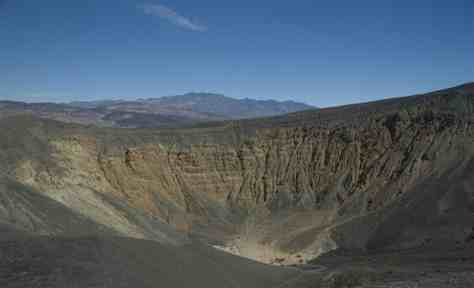It looks like you're using an Ad Blocker.
Please white-list or disable AboveTopSecret.com in your ad-blocking tool.
Thank you.
Some features of ATS will be disabled while you continue to use an ad-blocker.
2
share:
New evidence shows that the volcanic Ubehebe Crater that lies at California's Death Valley may be more active than previously thought.
Source

www.msnbc.msn.com...
There is a decent chance that this volcano could erupt in a few hundred years.
Source

California's Death Valley, already one of the hottest places on Earth, may have the potential to get a whole lot hotter — and live up to its name in a surprising (and possibly scary) new way, according to new research.
Scientists have long known that the craters that pepper this dry landscape were formed by long-ago volcanic eruptions, triggered when hot magma ascending from inside the planet hit pockets of water.
Some researchers now think the area erupted far more recently than thought, meaning the parched swath of central California, home to desolate salt flats and scalding temperatures, could be primed for a follow-up.
Dates for the geological catastrophe are fuzzy, but researchers used to think that Death Valley's largest crater, a half-mile (0.8 kilometer) wide gash in the Earth nearly 800 feet (240 meters) deep, formed in 4000 BC.
Yet new evidence uncovered by a team of scientists at Columbia University's Lamont-Doherty Earth Observatory suggests the dramatic crater, called Ubehebe, last erupted only 800 hundred years ago.
Although that may sound like ancient history, in geological time 800 years is a mere blip. And because the crater formed relatively recently, it might still be restive, and plenty of liquid hot magma may still be lurking beneath it.
The evidence comes from chemical signatures trapped in small fragments of rocks the team gathered near Ubehebe. Dating techniques and analysis revealed that the rocks were birthed by eruptions that happen once every 1,000 years or so, and that the most recent large eruption occurred around the year 1300.
www.msnbc.msn.com...
There is a decent chance that this volcano could erupt in a few hundred years.
reply to post by isyeye
Oh goodie, more doom and more need for research funding!
There is also a decent chance that it may not erupt for 6000 years or never again.
Oh goodie, more doom and more need for research funding!
There is a decent chance that this volcano could erupt in a few hundred years.
There is also a decent chance that it may not erupt for 6000 years or never again.
reply to post by isyeye
Very interesting article but at the same time it isn't a volcano to worry about - it isn't particularly explosive and is near to no population centres.
Good view for the tourists if it goes off though. Death Valley is one of the few natural wonders of America i have actually seen (relatives in California took us for a tour a LONG time ago). What stuck with me was what a totally weird place it is! And sooooooo hot it is unbearable.........
Very interesting article but at the same time it isn't a volcano to worry about - it isn't particularly explosive and is near to no population centres.
Good view for the tourists if it goes off though. Death Valley is one of the few natural wonders of America i have actually seen (relatives in California took us for a tour a LONG time ago). What stuck with me was what a totally weird place it is! And sooooooo hot it is unbearable.........
Please look around a bit before you post.
www.abovetopsecret.com...
^^This thread (the original) isnt even off the first page yet.
www.abovetopsecret.com...
^^This thread (the original) isnt even off the first page yet.
new topics
-
Paradox of Progress
Ancient & Lost Civilizations: 4 hours ago -
Joe Biden gives the USA's Highest Civilian Honor Award to Hillary Clinton and George Soros.
US Political Madness: 6 hours ago -
Winter Storm
Fragile Earth: 7 hours ago -
Biden Face Planted Somewhere
Politicians & People: 9 hours ago -
A great artist and storyteller, for kids of all ages
General Entertainment: 9 hours ago
top topics
-
Joe Biden gives the USA's Highest Civilian Honor Award to Hillary Clinton and George Soros.
US Political Madness: 6 hours ago, 13 flags -
What Is 'Quad Demic'? Mask Mandate Returns In These US States
Diseases and Pandemics: 13 hours ago, 11 flags -
Volcano Watch 2025
Fragile Earth: 15 hours ago, 8 flags -
The Future of fashion .
Social Issues and Civil Unrest: 14 hours ago, 8 flags -
Winter Storm
Fragile Earth: 7 hours ago, 7 flags -
Bin Cyber Junk…
Short Stories: 14 hours ago, 6 flags -
Biden Face Planted Somewhere
Politicians & People: 9 hours ago, 5 flags -
A great artist and storyteller, for kids of all ages
General Entertainment: 9 hours ago, 5 flags -
Paradox of Progress
Ancient & Lost Civilizations: 4 hours ago, 5 flags -
The Undertones - Teenage Kicks
Music: 15 hours ago, 3 flags
2
